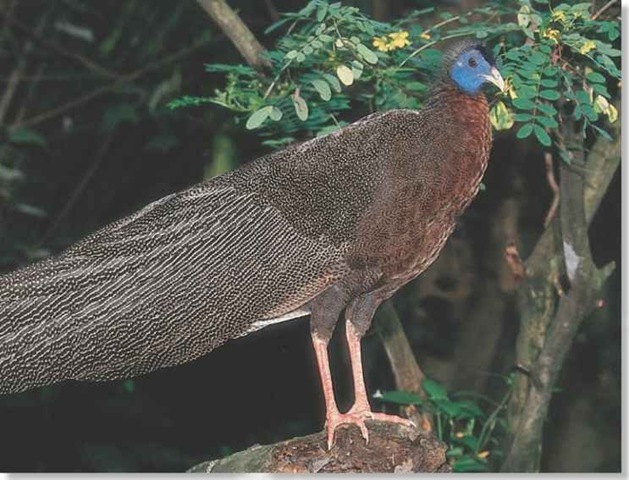ORDER
Galliform.es
FAMILY
Phasianidae
GENUS & SPECIES
KEY FEATURES
Displays the most remarkable plumage of any pheasant species
Boasts an extensive repertoire of calls, and is more often heard than seen Males perform an intense foot-stomping dancing ritual during breeding
WHERE IN THE WORLD!
Found in lowland forest areas in Borneo, Sumatra and the Malay peninsula in Southeast Asia near the South China Sea
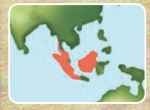
Lifecycle
The male great argus pheasant struts about fanning his grand display of feathers with a dazzling array of golden eyespots in an attempt to impress a female.
Habitat
The great argus pheasant favors mature forests up to 4,000′ above sea level. In Malaysia, it is found in lowland and dipterocarp forests. (Dipterocarps, native to Asia, have unusual “winged” seeds, which drift instead of falling straight down.) In the north, the bird frequents hillsides with evergreen vegetation. In Borneo, the bird dwells in lowland forests and in forests as high as 3,000′. At Kuala Lumpur, most argus pheasants prefer soil that is no more than 600′ from permanent water
Forest-dweller
The great argus pheasant can be found in a variety of leafy settings.
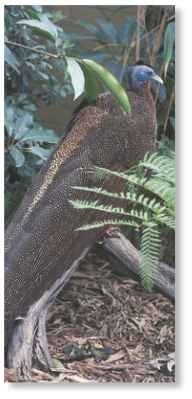
In Greek mythology, Argus was a god who had many eyes, which enabled him to see in all directions. The species name argus comes from the ocelli (eyes) that line the wings.
Males begin calling at about 1 year of age and perfect their calls before they are 2 years old.
Breeding
The male great argus pheasant performs an elaborate courtship display in a specially prepared area that is 72 sq. feet or larger: He meticulously cleans his dancing site, then attempts to impress females with his foot-stomping dance, concluding with an impressive display in which he creates a fan of feathers with his wings. He peeks through the funnel of ocelli (eyespots) with one eye to see if the female accepts. Copulation lasts only a few seconds. Once the birds mate, the female flies deep into the jungle where she lays her clutch, often near a large rainforest tree.The males do not appear to have any role in the nest or its defense. After almost a month of lone incubation, the female feeds the down-covered chicks for more than 40 days. She brings insects in her bill and passes them directly to the chicks’ mouths. The nestlings begin to hop with a series of consecutive jumps in preparation for flying.
the mating dance
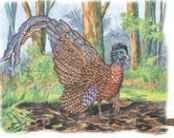
A clean house…
A male great argus pheasant advertises his cleared dancing arena by calling out to females early in the morning.
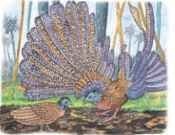
Step into my pad…
A female accepts the invitation and ventures into the male’s dancing ground. He circles around her, stomping his feet.
Food & feeding
The great argus pheasant slowly meanders and pecks at leaf litter on the ground and occasionally at the leaves on shrubs. Fallen fruits and ants top the menu, but the bird also eats other insects, as well as mollusks, leaves, nuts and seeds. The bird lifts its head after each peck to survey its surroundings for potential danger Females forage for food with their young, while the males embark on solitary searches.
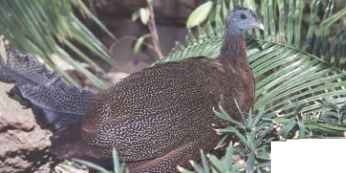
A Ants in the plants
A pheasant looks up to scan for predators before continuing to feed on ants and other insects.
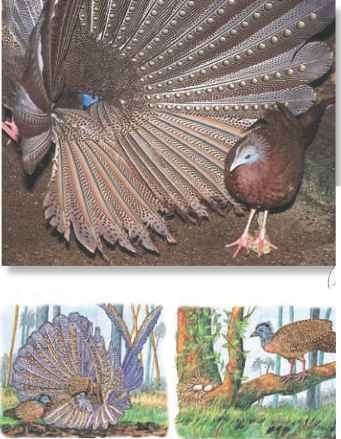
A fancy display…
The show begins; the male curves his wings upward and around, forming a huge funnel as he vibrates his tail and plumage
A family matter
After mating, the female is on her own; unable to carry nesting material, she forms a simple nest in a tree hollow for her two eggs.
Conservation
Forest destruction has limited the Malaysian range of the great argus pheasant. Lowland forests now cover only about 15% of the peninsula. Borneo is in less danger; at least 40% of its land area is covered by lowland forests. Humans trap the birds at display sites that are advertised by the males’ loud calls, and use the birds’ feathers as ornaments. In addition, the great argus pheasant competes with the crested argus pheasant for its habitat, though it is not clear which species excludes the other. Currently, the great argus pheasant is raised in aviaries around the world.
The reclusive great argus pheasant is more likely to be heard than seen. It spends most of the daytime perched, and is usually most active at sunrise and sunset. The male call is a loud, prolonged, musical kwow-wow, which carries great distances in the heavy forest. Nocturnal calling is frequent and at its loudest between February and August, the breeding season. At this time, the birds become more active and males have vocal contests for display sites. Males clean their display site by throwing leaves with the beak pecking at overhead vegetation and beating their wings \v^jS§yi’l^ki~ to fan away light debris. Both sexes are extremely ffU^Bfe, fast runners, but poor fliers; they rely on 9Bl acute hearing to warn them of impending danger
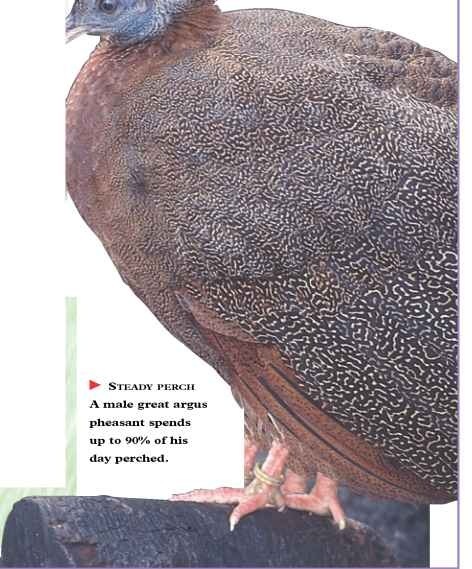
PROFILE
Great Argus Pheasant
The great argus pheasant normally has a drab appearance — but the male displays elegant underwing plumage during courtship rituals.

Creature comparisons
Like the great argus pheasant, the Bornean peacock pheasant (Polyplectron schleiermacheri) inhabits lowland forests of Borneo, but it is the only peacock pheasant found in the region. At 17-20″ long, it is much smaller than the great argus pheasant. The female of both species (shown at right) lacks the longer tails common in their male counterparts. But both sexes of the Bornean peacock pheasant have ocelli (eyespots) on their upperparts; ocelli are complete!) absent in the female great argus. Great argus pheasant
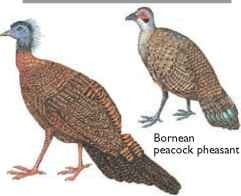
| VITAL STATISTICS | |
| Weight | Male 4.5-6 lbs.; female 3.53.75 lbs. |
| Length | Male up to 7′; female up to 2′ (including tail) |
| Sexual Maturity | 3 years |
| Breeding Season | February-August |
| Number of Eggs | 2-4 |
| Incubation Period | 24-26 days |
| Fledging Period | Up to 40 days |
| Birth Interval | More than 1 brood a year |
| Typical |Diet | Ants, plants, leaves, nuts and seeds |
| Lifespan | Unknown |
RELATED SPECIES
• The great argus pheasant is the only species in the genus Argusianus, which joins 15 other genera in the family Phasianidae. The family includes quails, partridges, pheasants, spur fowl, francolins and peafowl. The bobwhite quail, Colinus virginia-nus, a native of North America, is named for the male’s song, “bob-white.” The painted quail, Excalfactoria chinensis, is only 6″ long.
